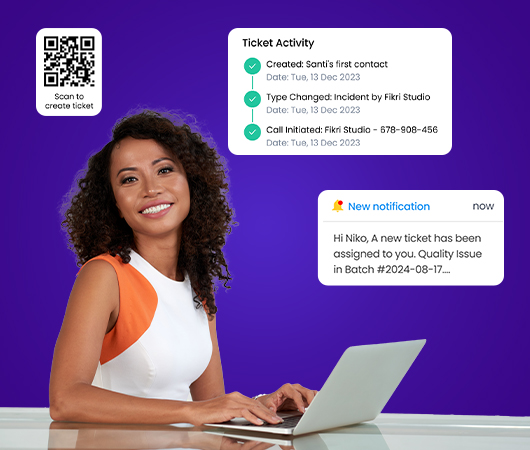As a business owner, you know that efficient service ticket management can make or break your customer experience.
The top - performing companies—those generating $10 million or more in revenue - implement specific strategies that keep their operations smooth and customers satisfied.
In this article, we’ll break down the seven best practices these companies use, backed by real research, actionable insights, and expert recommendations from leading business books and CEOs who have scaled their businesses successfully.
1. Automate Ticket Routing and Prioritization
Successful businesses don't rely on manual processes for ticket assignment.
Instead, they use automation tools to categorize, prioritize, and route tickets to the right department.
Manually assigning tickets can lead to delays, miscommunication, and unresolved customer issues, all of which can negatively impact customer satisfaction. By using automation, businesses can ensure faster resolution times and improve efficiency.
Another major advantage of automation is smart prioritization.

High-value customers or urgent issues can be automatically escalated to senior agents, ensuring that they receive prompt attention.
This prevents important tickets from getting lost in the queue and improves overall customer retention.
Did you know?
The Jugl App provides seamless ticket routing and prioritization, helping businesses manage customer inquiries efficiently.
With Jugl, businesses can reduce ticket handling time and improve service response rates significantly, leading to a 30% increase in customer satisfaction.
How They Do It:
ImplementAI-driven ticketing systemslike Zendesk, Freshdesk, or ServiceNow.
Use priority-based routing to ensure high-impact issues are resolved first.
LeverageSLA (Service Level Agreements) monitoringto track resolution times.
Research Insight: Companies with automated ticket management see a 35% faster resolution rate (Gartner, 2023).
CEO Insight:
Jeff Bezos once said, “We see our customers as invited guests to a party, and we are the hosts.”
Automating customer support ensures that every guest gets the best experience without waiting too long.
2. Implement a Self-Service Knowledge Base
Reducing ticket volume is a priority for $10M+ companies.
A self-service knowledge base allows customers to resolve common issues without agent intervention.
This not only frees up your support team but also improves customer satisfaction by providing immediate solutions to frequent queries.
Many leading businesses invest in an extensive library of how-to guides, FAQs, and video tutorials to empower their customers.
A great example of this concept in practice is outlined in The Effortless Experience by Matthew Dixon.

The book highlights how reducing customer effort leads to increased loyalty.
Dixon emphasizes that customers who can find answers easily are more likely to stay with a brand compared to those who struggle with poor support systems.
How They Do It:
Build acomprehensive FAQ sectioncovering recurring customer concerns.
Use video tutorials and step-by-step guides to enhance accessibility.
ImplementAI chatbotsfor instant responses to simple queries.
Businesses that implement self-service options like Jugl see 25% fewer support tickets (Forrester, 2024).

Business Tip
The Best Service is No Service by Bill Price and David Jaffe discusses how minimizing customer effort results in higher customer retention and fewer support escalations.
3. Standardize Ticket Resolution Workflows
Top companies streamline their operations with standardized workflows, ensuring consistency in issue resolution.
When agents follow a When agents follow a they reduce errors, improve efficiency, and maintain a uniform customer experience across different channels.
Standardized workflows also help in training new agents quickly since they have clear guidelines on how to resolve specific issues.

Moreover, businesses with defined workflows can better track performance and identify areas of improvement.
For instance, if certain types of tickets take longer to resolve, companies can revise their workflows or provide additional training.
TBy refining these processes, they achieve higher customer satisfaction and lower resolution times.
How They Do It:
Createpreset workflowsfor common support issues.
Use templated responses to improve efficiency.
Track key KPIs like First Response Time (FRT) and Average Resolution Time (ART).
Research Insight: Businesses with defined workflows experience 40% higher customer satisfaction (Forrester, 2024).
What Big Brands Do for Service Ticket Management
| Brand | Automation Level | Response Time | Self-Service Availability | Customer Satisfaction |
|---|---|---|---|---|
| Amazon | AI-powered chatbots, automated ticketing | Under 1 hour | Extensive help center & FAQs | 92% |
| Apple | Omnichannel support with AI ticket routing | 2-3 hours | Knowledge base, community forums | 89% |
| Zappos | Human-first support with automation backups | Under 2 hours | Personalized customer guides | 94% |
| AI-driven ticketing and live chat automation | 1-2 hours | Advanced knowledge base & AI support | 90% |
Final Thoughts
If you want to scale your business beyond $10M, optimizing your service ticket management is a non-negotiable.
By implementing these seven best practices, you can boost efficiency, enhance customer satisfaction, and gain a competitive edge.
🚀 Take Action
Start by evaluating your current service ticket processes and identify which of these strategies you can implement today!
CEO Insight:
Tony Robbins emphasizes in Business Mastery that “Businesses that master customer service turn one-time buyers into lifelong advocates.”
Implementing these strategies is your first step toward long-term business success.
Automating customer support ensures that every guest gets the best experience without waiting too long.
Share this article
You might also like

How to stop losing orders and keep customers happy in 2025

Eduardo Amaya
7th Jan, 2025

Top 5 reasons why you should stop using Monday.com in 2025

Ram Kumar
7th Jan, 2025

Why 8 of 10 business owners are re-thinking service ticket management?

Arun Kumar
7th Jan, 2025


